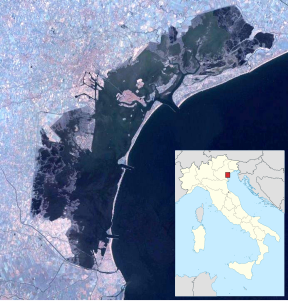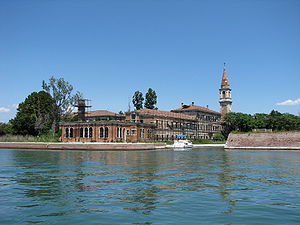Poveglia
| Poveglia | ||
|---|---|---|
| Poveglia seen from the Lido, on the left the hospital and the fortress island Ottagono Poveglia in front of it | ||
| Waters | Venice lagoon | |
| Geographical location | 45 ° 22 '56 " N , 12 ° 19' 50" E | |
|
|
||
| length | 345 m | |
| width | 335 m | |
| surface | 7.51 ha | |
| Highest elevation | 2 m | |
| Residents | uninhabited | |
| The Lazzaretto , next to it the church tower of San Vitale, and on the right in the foreground Ottagono Poveglia | ||
The island of Poveglia , not to be confused with the island of Ex Poveglia , is located about five kilometers south of the old town of Venice , at the height of Malamocco in the Venice lagoon and has an area of around 7.5 hectares . Only 16 meters south of it is the much smaller island of Ottagono Poveglia .
history
The name of the island goes back, so it was speculated, to a Roman family, because in the sources it often appears under the name "Pupilia" or "Popilia". It is more likely to be derived from one of those Roman roads that crossed the lagoon's hinterland.
According to legend, the island was settled by mainland residents fleeing Attila in the 5th century . During the unsuccessful siege by Pippin , the son of Charlemagne , it was depopulated in 809 and remained deserted until 864.
From 864, after the murder of Doge Pietro Tradonico , Venetian families were settled on Poveglia and a Gastalde was responsible for the exercise of power; the islanders belonged to the local parish of San Vitale. In the 9th century, Johannes Diaconus counted Poveglia to the twelve main islands of the lagoon. An edict of April 912 made Chioggia responsible for transport tasks up to this island.
In the course of the 9th century Venice succeeded in gaining a clear preponderance over all other islands in the lagoon. The Povegliani were too independent of the city. In 1281 the great council decided that the people of the island were allowed to have tabernam , from whose income the necessary bank reinforcements and canal works were to be financed. They should also receive up to 200 Libra for these tasks . In 1339 the Great Council was given a free hand to appoint rectors on some of the lagoon islands, including Poveglia. In the second half of the 14th century, the island's inhabitants were scattered to the wind.
In order to use the island, a shipyard and a warehouse for equipping the ships were built there, which mainly served the Malamocco harbor. In the 17th century the island was sometimes called Povera .
In 1782 the Magistrato della Sanità submitted a motion to the Senate to build a hospital on the almost depopulated island, and in 1793 a temporary lazzaretto was actually built. Since the first sick suffered from the plague , the island was cordoned off with armed boats and wooden houses were built for the sick and the guards. In 1799 a Spanish ship, also afflicted by the plague, was quarantined there by two boats bringing the 31-man crew to the island. As in 1793, the plague did not spread to the city, although eight men died. A memorial stone was erected near the pier in 1793 with the inscription “Ne fodias / vita functi contagio / requiescunt” ( German do n't dig, those who died of the infection rest here ). In 1803 yellow fever broke out in Spanish areas , only Venice dared to keep its port open for the ships there; the quarantine took place on the hospital islands, including Poveglia. Although there was a decision to build a large hospital on the island in 1805, on February 19, 1809 the kingdom decided to build a corresponding building on Poveglia. But the war, then the conflicts over the fortifications and the powder magazines delayed the plans further. When the Ottoman ports reported epidemics in 1814, Vienna closed the port of Trieste and sent the appropriate teams to Venice. On October 12, 1814, the military left the island to the health authorities. The Santo Stefano from Smyrna was the first to land . The island also proved itself in warding off the plague from 1817 to 1821, even when it was brought to Venice by two ships from Alexandria in 1819 . While the plague largely disappeared, cholera epidemics began in 1822, culminating in the years 1831–1832, when 702 suspects were admitted.
From 1922 to 1968, Poveglia was a branch of the Venetian retirement and infirmary homes. The island has been deserted since the 1970s. In addition to the vacant buildings, abandoned vineyards and vegetable gardens dominate the island. In 2014, the Italian state decided to auction a 99-year right of use for Poveglia to the highest bidder. Then an association ( Italian Poveglia per tutti ) was formed to prevent the island from being privatized. The island remained state property, as an offer from entrepreneur Luigi Brugnaro of 513,000 euros was considered too low.
literature
- AA Frari: Cenni storici sull'isola di Poveglia e la sua importanza sotto l'aspetto sanitario , Venice 1837. ( digitized version )
Web links
Remarks
- ^ AA Frari: Cenni storici sull'isola di Poveglia e la sua importanza sotto l'aspetto sanitario , Venice 1837, p. 30.
- ^ Arcangelo Fornaro: Problemi di metrologia nell'opera di Polibio , Edipuglia, Santo Spirito 2005, p. 49.
- ↑ Ermolao Paoletti: Il fiore di Venezia ossia i quadri, i monumenti, le vedute ed i costumi veneziani , Volume 1, Tommaso Fantana, Venice 1837, p. 187 ( digitized version ).
- ^ Heinrich Kretschmayr : History of Venice , Vol. 1, Gotha 1905, p. 29.
- ^ Timothy Peter Wiseman: Roman Studies. Literary and Historical , Francis Cairns Publications, 1987, p. 107.
- ^ For example, in Hermannus Wesseling: Nomognosticon juris universi Theorico-Practicum: sive aurifodina politiae legalis tam canonicae quam civilis ... , Cologne 1686, p. 576.
- ^ AA Frari: Cenni storici sull'isola di Poveglia e la sua importanza sotto l'aspetto sanitario , Venice 1837, pp. 15-17.
- ↑ Walter Mayr: Der Fluch der Lagune , in: Der Spiegel, September 22, 2014.
- ↑ Daniel Bakir: Venice's demon island goes under the hammer. 2014, accessed May 4, 2016 .
- ↑ Antje Blinda: Sale in Italy: Venetians want to save the island by crowdfunding. April 16, 2014, accessed April 16, 2014 .
- ↑ Alessia Pirolo: Italy remains seated on its real estate. July 12, 2014, accessed August 7, 2014 .

